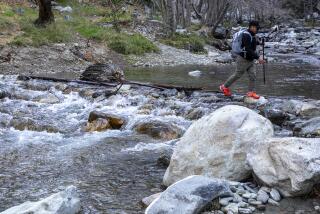
- Share via
- The new maps include Oakland and Santa Rosa, scenes of deadly fires, along with Northern California’s wine country.
- New fire hazard maps for the entire state will be released by March 24, and are expected to add at least 1.4 million acres into zones where many heightened fire safety regulations are required.
Cal Fire released new fire hazard severity maps for coastal Northern California on Monday as part of a two-month rollout process that ends with Southern California on March 24.
The new maps include Oakland, the site of the 1991 Tunnel fire that killed 25, and Santa Rosa, which is still recovering from the 2017 Tubbs fire that killed 22. It also includes Northern California’s wine country, which has been plagued by devastating fires including the Kincade fire in 2019 and the Ranch fire in 2018.
Fourteen out of the 109 cities mapped in the coastal Northern California region saw a decrease in acreage for the highest-risk fire zones, including Oakland. That compares with one of 35 cities seeing such a decrease for Cal Fire’s inland Northern California map released two weeks ago.
New fire hazard zones for the North Coast and Bay Area
Local responsibility areas (proposed)
Moderate
High
Very high
Non-wildland
State responsibility areas
Moderate
High
Very high

DEL NORTE
HUMBOLDT
Eureka
MENDOCINO
YOLO
SONOMA
NAPA
SOLANO
MARIN
CONTRA
COSTA
SAN
JOAQUIN
Oakland
SAN FRANCISCO
ALAMEDA
STANISLAUS
SAN MATEO
San Jose
SANTA
CLARA
MERCED
SANTA CRUZ
50 MILES

Eureka
Mendocino
Santa Rosa
Oakland
San Francisco
San Jose
50 MILES
Santa Cruz
California Department of Forestry and Fire Protection
Sean Greene LOS ANGELES TIMES
The release comes just weeks after the devastating Palisades and Eaton fires in Los Angeles County triggered questions around the accuracy of Cal Fire’s mapping process. The maps are being released more than three years after the state Legislature required the agency to better identify wildfire hazard in cities and other developed areas where local city and county fire departments are responsible for putting out blazes.
Gov. Gavin Newsom’s office said the maps, when completed, would add at least 1.4 million acres across the state into zones where many heightened fire safety regulations are required, more than doubling the land under local fire departments’ purviews with these highest severity designations. More than 360,000 of those acres are in the coastal Northern California region.
The vast majority of homes destroyed in the Eaton fire were outside of Cal Fire’s “very high” fire hazard severity zones, yet a newer approach by an independent company had found Altadena had “severe” wildfire risk.
Cal Fire released new maps for the land where it is responsible for responding to fires in 2023, including “moderate,” “high” and “very high” zones. While Cal Fire mapped “very high” zones for the local responsibility areas over a decade ago, the new maps now include “high” and “moderate” zones as well.
The state law requiring the new mapping also extends the fire safety regulations that applied to the “very high” zone to the “high” zone as well. These include defensible space requirements and home hardening measures in new constructions, such as using ignition-resistant building materials, covering vents that could allow embers to enter the home and installing multipaned or fire-resistant windows.
Oakland saw the largest decrease in acres zoned in the “very high” and “high” regions. While the 2011 maps designated more than 10,000 acres as “very high,” the new maps designate only 1,945 as “very high” and 2,598 as “high.”
Berkeley also saw a notable decrease, with its “high” and “very high” acreage slashed in half.
Proposed fire hazard severity zones in local responsibility areas
Moderate
High
Very high
Jurisdiction
Local
State
Federal

Richmond
Tilden
Nature
Area
Walnut Creek
UC BERKELEY
Sausalito
Berkeley
Angel Island
State Park
OAKLAND HILLS
Oakland
2011 “very high”
hazard severity
zone
San Francisco
Lake Chabot
Regional Park
Oakland
International
Airport
San Francisco
Bay
5 MILES
Hayward

Richmond
Tilden
Nature
Area
Sausalito
Berkeley
Angel Island
State Park
OAKLAND HILLS
Oakland
San Francisco
2011 “very high” hazard severity zone
San Francisco
Bay
5 MILES
California Department of Forestry and Fire Protection
Sean Greene LOS ANGELES TIMES
In a statement to The Times, Cal Fire said a few factors could explain the changes in acreage but would not elaborate on specific cities or counties. The agency said the new maps used an updated fire model with more detailed climate and extreme weather data.
The model calculates the probability and intensity of fire in wildlands and estimates how far fire could penetrate into a populated area. Consequently, any wildlands that have been developed since the previous maps could’ve seen a change in hazard, the agency said.
A new technique for modeling fire behavior at the wildland-urban interface that better estimates how wind-driven embers impact fire spread also drove significant changes in zoning, the agency said.
San Jose saw the largest increase in acres zoned in “high” and “very high.” Cal Fire added nearly 20,000 acres into the zones, including large swaths of the outer city that push up against the coastal redwood forests and Diablo mountain range. Cupertino, neighboring San Jose, saw its two highest hazard zones balloon from 16 acres to nearly 1,600.
Proposed fire hazard severity zones in local responsibility areas
Moderate
High
Very high
Jurisdiction
Local
State
Federal

Hayward
San Francisco
International
Airport
San Mateo
Fremont
Redwood City
DIABLO RANGE
PALO ALTO
HILLS
San Jose
Cupertino
Año Nuevo
State Park
2011 “very high”
hazard severity zone
Morgan
Hill
5 MILES
Scotts Valley

Hayward
San Francisco
International
Airport
San Mateo
Fremont
Redwood
City
DIABLO
RANGE
PALO ALTO
HILLS
San Jose
Cupertino
Año Nuevo
State Park
2011 “very high”
hazard severity zone
5 MILES
Morgan
Hill
Scotts Valley
California Department of Forestry and Fire Protection
Sean Greene LOS ANGELES TIMES
Unincorporated Sonoma County, part of California wine country and home to the greater Santa Rosa area, saw its “high” and “very high” zones explode from just 11 acres in the old maps to more than 16,700.
Mendocino and Napa counties, deep in wine country, also saw significant increases, although most of the counties’ land falls under Cal Fire’s state responsibility areas, not the local responsibility areas subject to the new maps.
Proposed fire hazard severity zones in local responsibility areas
Moderate
High
Very high
Jurisdiction
Local
State
Federal

Healdsburg
Lake Berryessa
Calistoga
Santa Rosa
Sebastopol
2011 “very high” hazard severity zone
Napa
5 MILES

Lake
Berryessa
Healdsburg
Calistoga
Santa Rosa
Sebastopol
2011 “very high” hazard severity zone
Napa
5 MILES
California Department of Forestry and Fire Protection
Sean Greene LOS ANGELES TIMES
Cal Fire’s new models better account for how flying embers contribute to fire spread, calculate hazard based on the most extreme windy and dry conditions possible and use more detailed and up-to-date climate data. While the new “high” zone is responsible for much of the increase in acreage, it wasn’t immediately clear which factors contributed to the increases and decreases in the “very high” zoning.
The release triggers a roughly five-month clock where local governments take public input on the new maps before officially adopting them and applying stricter regulations. Local jurisdictions can choose to increase the severity zoning of regions, but they cannot decrease them.
Cal Fire is adamant the hazard maps have no direct effect on residents’ insurance rates, saying the maps identify hazard — the chance of an area experiencing wildfire — not the risk of specific homes burning down. Some fire safety experts pointed out that the increased fire safety measures required in higher-hazard communities can encourage insurance companies to decrease premiums.
PDFs for each city and county, along with more information and acreage data, are available on Cal Fire’s website.









